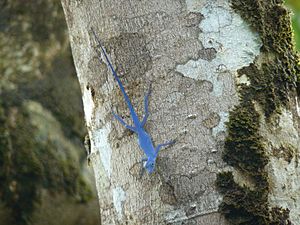Blue anole facts for kids
Quick facts for kids Blue anole |
|
|---|---|
 |
|
| Conservation status | |
| Scientific classification | |
| Genus: |
Anolis
|
| Species: |
gorgonae
|
The blue anole (Anolis gorgonae) is a special kind of lizard that lives mostly in trees. It's part of a group called Dactyloa, which are all good at climbing. The blue anole is quite small and skinny. It's known for its amazing bright blue color, which is very rare for lizards! This unique lizard is found only on a small island called Gorgona in Colombia, South America. Because it's found in such a small area, it's considered near-threatened, meaning its population could be at risk.
About the Blue Anole
Both male and female blue anoles are a beautiful pure blue color. This bright blue is very unusual for lizards! Male blue anoles also have a pure white dewlap, which is a flap of skin under their throat. Some of these lizards have darker spots on their head and neck.
The blue anole is special among all anoles not just for its color, but also because it's smaller and slimmer than other lizards in the Dactyloa group. These lizards usually live high up in trees, often on open branches or on the main tree trunks. They are mostly found in areas of the island where people live.
Protecting the Blue Anole
It's hard to know exactly how many blue anoles there are because they live in a remote rainforest and stay high off the ground. This makes them hard to find and count.
Sadly, these blue anoles can become food for other animals. Some lizards, like the western basilisk, have been brought to the island and can hunt the blue anoles. Other animals like rats, cats, and capuchin monkeys, which were also introduced to the island, might also hunt them.
A long time ago, in the 1950s, a building project on the island caused some damage to the blue anole's home. However, since 1984, the entire island of Gorgona has become a protected national park. This means the island and its animals, including the blue anole, are now safe from further habitat destruction. Scientists have even suggested that some blue anoles could be raised in special programs to help increase their numbers.
See also
 In Spanish: Lagarto azul de Gorgona para niños
In Spanish: Lagarto azul de Gorgona para niños
- List of Anolis lizards
- Lygodactylus williamsi, a similar threatened lizard



